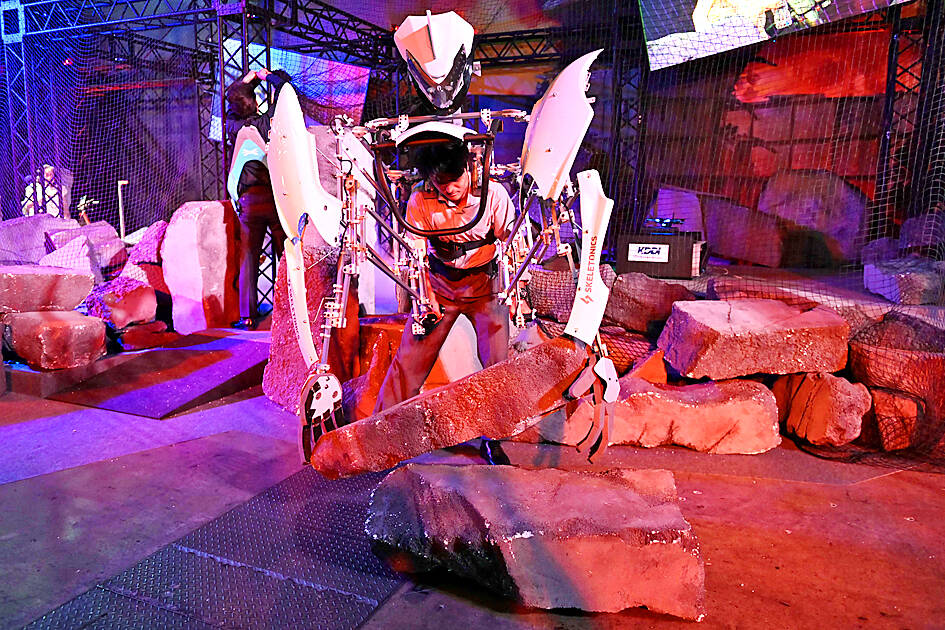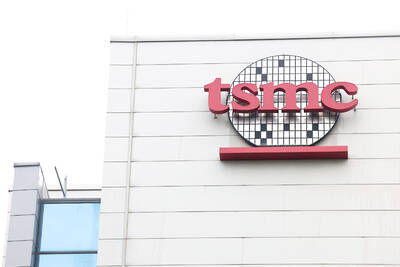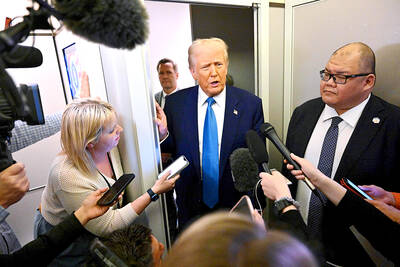With a drone camera, a survivor is spotted in the rubble. A robot on tracks brings him water while rescuers in exoskeletons clear an escape route for an autonomous stretcher to take her to safety.
This is the futuristic vision on display at the Japan Mobility Show, aiming to exhibit how technology can help and sometimes replace humans in a country short of workers and no stranger to disasters.
However, so as not to alarm people, the imaginary tragedy is caused by Godzilla, who has unleashed catastrophe in Japanese disaster films since the 1950s. In Japan nearly 30 percent of the country’s population is 65 or older.

Photo: AFP
“Because of the decline of the population there are fewer and fewer people available for dangerous tasks,” said Tomoyuki Izu, founder of Attrac Lab, a local start-up specializing in autonomous mobility.
“My idea is to help people such as firefighters with my machines,” Izu, 61, said.
It was Attrac Lab that codeveloped the small delivery robot squeezing through the cardboard rubble at the Japan Mobility Show and designed the remote-control stretcher on wheels or tracks.
For now the Japanese government favors “traditional equipment” for relief efforts, he said at the event, which opened to the public yesterday.
However, Izu believes there will eventually be a market for more advanced technology.
“There’s a lots of anime with humanoid robots in Japan, and therefore people love them, but these kinds of autonomous vehicles are still very strange for them,” he said.
Since 2016, Japan’s Kawasaki Heavy Industries Ltd (KHI) has been developing Kaleido, a robust humanoid robot capable of delicately lifting and moving injured people.
“In the future, this robot will be able to save people, or go to dangerous zones, like fires,” said Itsuki Goda from the robotics division of KHI.
He conceded that the machine needs more development on its scanning capabilities to get through difficult terrain.
“We need more years of development if we want to use it in real situations, where conditions are always different,” he said.
Kaleido’s current load capacity of 60kg would be increased soon with a new prototype, Goda said.
Price is also an issue.
Right now this robot is “maybe 10 times more expensive than a human, but if we produce 10,000 of them per year, the price will go down rapidly,” Goda added.
Since the Fukushima Dai-ichi nuclear power plant disaster in 2011, another niche segment has exploded: robots to clear up disaster areas that are difficult or dangerous to access.
Engineering firm Sugino Machine Ltd presented a powerful, but small, robotic arm rigged on crawlers that can work in areas that emergency workers cannot go.
The machine was built in 2018 for a nationally run atomic research agency, as Japan continues the work to decommission the Fukushima Dai-ichi nuclear power plant.
“This can be used for initial damage assessment or to remove debris or to remove heavy items that people cannot lift,” said Akira Inujima from Sugino Machine.
Tools can be attached to its arm, such as image, temperature or radioactivity sensors, or a high-pressure water lance.
“We have a shortage of labor. It is difficult to go all robot, but we can offer solutions to help people’s work,” he said.
“After Fukushima, we have been able to continue technological development because there has been project after project [heavily supported by the government], like removing debris, that needs our work,” he said. “It’s important to continue this work and not make this fade away.”

When an apartment comes up for rent in Germany’s big cities, hundreds of prospective tenants often queue down the street to view it, but the acute shortage of affordable housing is getting scant attention ahead of today’s snap general election. “Housing is one of the main problems for people, but nobody talks about it, nobody takes it seriously,” said Andreas Ibel, president of Build Europe, an association representing housing developers. Migration and the sluggish economy top the list of voters’ concerns, but analysts say housing policy fails to break through as returns on investment take time to register, making the

‘SILVER LINING’: Although the news caused TSMC to fall on the local market, an analyst said that as tariffs are not set to go into effect until April, there is still time for negotiations US President Donald Trump on Tuesday said that he would likely impose tariffs on semiconductor, automobile and pharmaceutical imports of about 25 percent, with an announcement coming as soon as April 2 in a move that would represent a dramatic widening of the US leader’s trade war. “I probably will tell you that on April 2, but it’ll be in the neighborhood of 25 percent,” Trump told reporters at his Mar-a-Lago club when asked about his plan for auto tariffs. Asked about similar levies on pharmaceutical drugs and semiconductors, the president said that “it’ll be 25 percent and higher, and it’ll

NOT TO WORRY: Some people are concerned funds might continue moving out of the country, but the central bank said financial account outflows are not unusual in Taiwan Taiwan’s outbound investments hit a new high last year due to investments made by contract chipmaker Taiwan Semiconductor Manufacturing Co (TSMC, 台積電) and other major manufacturers to boost global expansion, the central bank said on Thursday. The net increase in outbound investments last year reached a record US$21.05 billion, while the net increase in outbound investments by Taiwanese residents reached a record US$31.98 billion, central bank data showed. Chen Fei-wen (陳斐紋), deputy director of the central bank’s Department of Economic Research, said the increase was largely due to TSMC’s efforts to expand production in the US and Japan. Investments by Vanguard International

WARNING SHOT: The US president has threatened to impose 25 percent tariffs on all imported vehicles, and similar or higher duties on pharmaceuticals and semiconductors US President Donald Trump on Wednesday suggested that a trade deal with China was “possible” — a key target in the US leader’s tariffs policy. The US in 2020 had already agreed to “a great trade deal with China” and a new deal was “possible,” Trump said. Trump said he expected Chinese President Xi Jinping (習近平) to visit the US, without giving a timeline for his trip. Trump also said that he was talking to China about TikTok, as the US seeks to broker a sale of the popular app owned by Chinese firm ByteDance Ltd (字節跳動). Trump last week said that he had